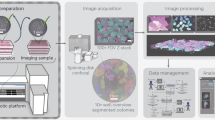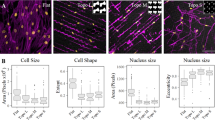Abstract
‘CELLOPHANE’ has for some years been recognized as a material on which monolayers of many cell types can be grown1. When a sheet of ‘Cellophane’ is so covered with cells it can be cut up into small pieces which are suitable for a number of uses.
This is a preview of subscription content, access via your institution
Access options
Subscribe to this journal
Receive 51 print issues and online access
$199.00 per year
only $3.90 per issue
Buy this article
- Purchase on Springer Link
- Instant access to full article PDF
Prices may be subject to local taxes which are calculated during checkout
Similar content being viewed by others
References
Evans, V. J., and Earle, W. R., J. Nat. Cancer Inst., 8, 103 (1947).
Nagington, J., and Greaves, R. I. N., Nature, 194, 993 (1962).
Nagington, J., and Lawrence, M. F., Mon. Bull. Min. Hlth. and Pub. Hlth. Lab. Service, 21, 162 (1962).
Stulberg, C. S., Rightsel, W. A., Page, R. H., and Berman, L., Proc. Soc. Exp. Biol., Med., 101, 415 (1959).
Author information
Authors and Affiliations
Rights and permissions
About this article
Cite this article
NAGINGTON, J. Monolayer Tissue Culture on ‘Cellophane’ Squares. Nature 200, 1022–1023 (1963). https://doi.org/10.1038/2001022b0
Issue Date:
DOI: https://doi.org/10.1038/2001022b0
Comments
By submitting a comment you agree to abide by our Terms and Community Guidelines. If you find something abusive or that does not comply with our terms or guidelines please flag it as inappropriate.



